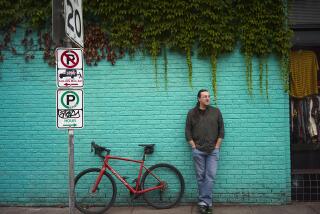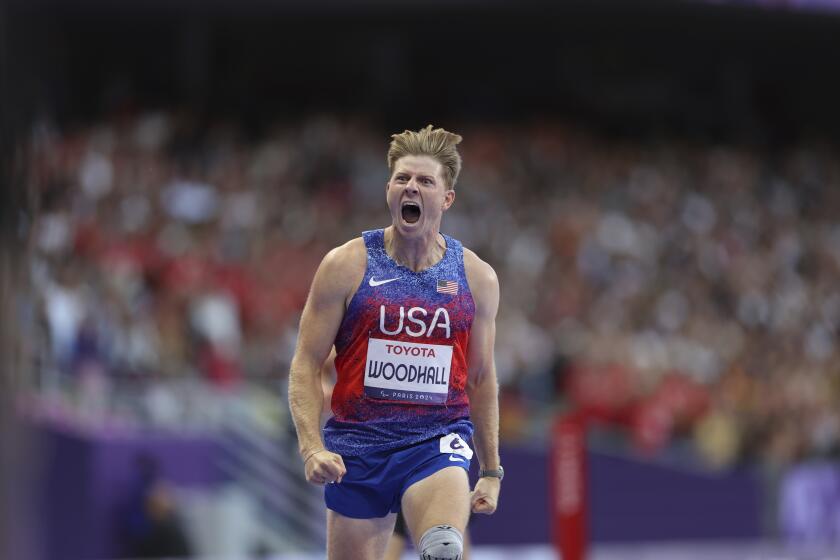On the Roll Again : Starting With the ’84 Olympics, Bicycling Has Captured the Hearts--in Addition to the Legs--of Millions of Americans of All Ages
During a recent cycling event that attracted nearly 1,000 riders, one bicyclist rode a rusty store-bought bike complete with kickstand and fenders. He wore cutoff jeans and a T-shirt, black socks, worn-out tennis shoes and a baseball cap. In the water bottle cage he’d wired onto the bike frame, he had placed a glass barbecue sauce bottle filled with water.
This rider may not have adopted the popular image of today’s cyclist, but he had captured the essence of cycling. As he rode along the metric-century course (62 miles), the man was having the time of his life.
Despite the emphasis on equipment, sleek and shiny Lycra fashions, high-tech components and brightly colored bike frames constructed of exotic materials, bicycling is still what it has always been: the sport that makes you feel like a kid again. And in case you haven’t noticed, it’s booming as never before.
Several Million Cyclist
According to Bill Tigue, Southern California manager of California Bicyclist magazine, there are several million cyclists and about 700 bicycle shops in the Southland.
“Southern California is a hotbed of cycling, primarily due to demographics and a climate that allows year-round participation,” he said.
Jim Leis, general manager of Claremont-based ProBike, a chain of five bicycle shops in the Los Angeles area, adds: “The Los Angeles Basin constitutes 7% to 10% of the U.S. cycling market. The sport took off during the ’84 Olympics and it continues to grow.”
During the 1984 Olympic Games, American cyclists grabbed gold, silver and bronze medals in unprecedented numbers, drawing media exposure for competitive cycling in the process. In 1986, Greg LeMond won the Tour de France, the first Yankee to triumph in the world’s most prestigious bicycle race. At last there were American heroes to emulate.
Their success attracted corporate sponsorship and money to cycling, increasing its visibility and appeal. As further proof that the sport has arrived, racing cyclists are featured on 10 million boxes of Wheaties.
Cycling has experienced booms in the past, said I. Martin, owner of I. Martin Imports in West Los Angeles. The most recent was in the early ‘70s.
Embedded in the Minds of Adults
“But this one is different,” he said. “This one will level off with cycling embedded in the minds of adults as something they can do, something they can get involved with. Bicycling has come of age.”
Most observers agree that the exposure gained during the Los Angeles Games, the increased interest in health and fitness and the development of the mountain bike are responsible for the surging popularity of cycling among adults.
Easier on the knees than running, bicycling is an excellent aerobic conditioner. Drew Smith, manager of Hostelhaus in Manhattan Beach, said: “We’re seeing a lot of former runners who are concerned about the detrimental effects on the body from all that impact. A lot of people between 30 and 40 are turning to bicycling as their main fitness sport.”
The evolution and affordability of the mountain bike, however, is perhaps the most significant factor that continues to attract adults to cycling. More accurately called all-terrain bikes (or ATBs), these sturdy bicycles with their knobby tires, thumb shifters and comfortable, upright seating positions are easy and fun to ride.
Reminiscent of the balloon-tired bikes of years ago, mountain bikes appeal to many adults who are hesitant to ride lightweight, skinny-tired bikes with turned-down handlebars and shift levers attached to the frame. Although mountain bikes now account for 60% to 70% of new bicycle sales, fewer than 10% of them are ridden off-road, where they’ve been banned in many places. Instead, the bikes are frequently ridden for commuting, running errands and all-purpose pleasure riding.
Whatever type of riding you want to do, the best place to learn about bicycling is in a good bike shop. If you haven’t been in one since the latest boom began, you’re in for a surprise. The sometimes-elitist, condescending attitude of “bikies” who once staffed the shops has, by and large, given way to a more helpful approach. You’re likely to encounter knowledgeable, personable individuals who are genuinely interested in helping customers select appropriate equipment.
Bob Howells, cycling columnist for City Sports magazine, suggests that you look for a bike shop with a friendly, open feeling.
“It should have a sense of community about it, and the staff should show a personal interest in you,” he says.
I. Martin agrees: “Our staff is trained in a manner that reflects our cycling experience, practical knowledge and philosophy. They are there to sell the product and to establish rapport and long-term relationships with the customer.”
In addition to a pleasant atmosphere, look for a shop that’s actively involved in the cycling community. Many shops feature weekly rides, occasional workshops and clinics.
Better Service
Better, less intimidating service is not the only difference you’ll notice. Flashy skintight Lycra clothing is prominently displayed on racks and mannequins; exotic foods, from energy bars to liquid carbohydrate supplements, promise enhanced athletic performance. Cycling gloves, glasses, helmets, shoes, computers, components, books, videos, software and car racks--even a partial list of accessories is almost overwhelming.
Talk with a shop staff person about the type of riding you intend to do to avoid confusion and get exactly what you need for yourself. Your equipment needs will vary depending on whether you want to cruise the strand or train for a century ride.
Your most obvious need, of course, is the right bicycle. Stu Harold, bicycle salesman at Two Wheel Transit Authority in Huntington Beach, says: “There are a lot of good bikes in the $400 range. When people buy cheap bikes, they invariably end up replacing them due to maintenance and performance problems. A quality bike will last for years and bring greater satisfaction.”
You can spend more than $2,000 for a top-of-the-line bike, but you don’t need to. “People who have more money than they know what to do with come in here and buy the most expensive bike they can get just to look good once a week,” Harold said.
Expect to spend from $300 to $500 for a good, entry-level mountain or road bike that will offer consistent performance and reliability. Well-designed components, a chrome-moly steel or aluminum frame, excellent brakes and lightweight rims are characteristics of bikes in this price range.
Mandatory Equipment
There are several accessories that are virtually mandatory for safety and comfort. The most important is a helmet. Head injuries can be severely debilitating, even fatal; a helmet minimizes the risk in case of an accident. The new generation of cycling helmets was developed in response to the United States Cycling Federation’s 1986 ruling mandating that helmets be worn in all sanctioned events.
Today’s helmets are lighter in weight, cooler and more comfortable than any previously made, yet they still conform to the standards of the American National Standards Institute.
Other essential accessories include cycling gloves that protect the palms, and sleek, padded cycling shorts that are comfortable and protective. Cycling shoes, with their stiff soles, provide for efficient power transfer from pedal to wheel. Sunglasses protect from bugs, other airborne objects and sunlight. Jerseys are cut close to the body to reduce wind resistance, their bright colors maximize visibility in traffic, and the pockets in back are for carrying food and incidentals.
Over $100 on Accessories
A water bottle, patch kit, pump and a few tools are other important accessories. Plan to spend upwards of $100, depending on your tastes and needs.
The social aspect of cycling makes it attractive to individuals and families alike. On any given weekend, there are dozens of organized bike rides to choose from. Many are designed to benefit charities; others are simply regular club rides. Such rides are listed in the calendar sections of several free cycling publications available in most bicycle shops.
Don’t be intimidated by the trappings: the trendy clothes, the fancy components or the occasionally elitist attitude of some racers.
As Howells says: “There is no more egalitarian vehicle than the bicycle. It’s the great machine for the common man. A bike is so simple and so pure; it just wants you to hop on and ride.”
More to Read
Go beyond the scoreboard
Get the latest on L.A.'s teams in the daily Sports Report newsletter.
You may occasionally receive promotional content from the Los Angeles Times.







